Chancler Harrison recalls his time working on Echoes of Eternea vividly. “My work involved 100’s of hours with the promise of getting paid once the project was released,” he wrote in a March 2016 Imgur post. “Stupid, I know,” Harrison later told me over email. “I really wanted the game to succeed and in a way, I felt like I too was Kickstarting the project by working with no pay. I did not want to pull costs that would have been taken from elsewhere.”
Harrison was another of at least 1,456 people who believed in the game. Where he donated his work, the rest donated their money to the tune of $43,196. The Kickstarter campaign ended on May 6, 2012, but it would be another three years before that belief faded and the cold facts of reality set in. By late 2014, work on Echoes of Eternea was abandoned. Backers wouldn’t get the memo until June 2015, when Jeremy Hill, the original writer of the game, delivered the news. He did so under the name “Dutch” in the campaign’s comment section.
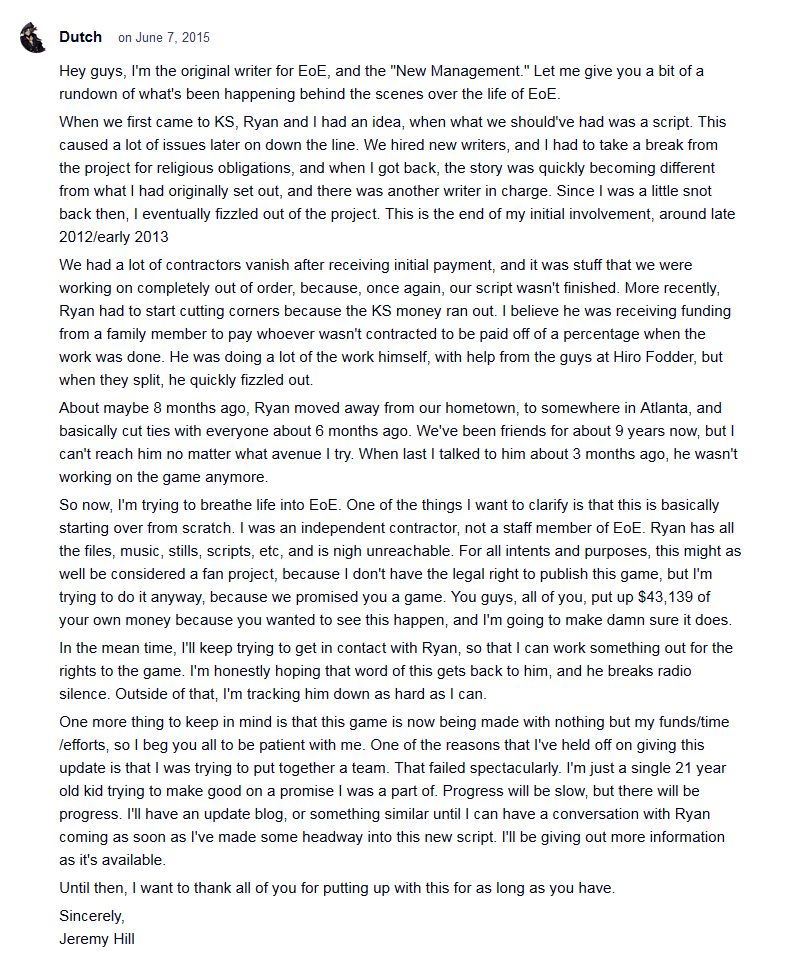
Jermey Hill’s full comment.
“About maybe 8 months ago, Ryan moved away from our hometown, to somewhere in Atlanta, and basically cut ties with everyone about 6 months ago. We’ve been friends for about 9 years now, but I can’t reach him no matter what avenue I try. When last I talked to him about 3 months ago, he wasn’t working on the game anymore.
“So now, I’m trying to breathe life into EoE. One of the things I want to clarify is that this is basically starting over from scratch. […] Ryan has all the files, music, stills, scripts, etc, and is nigh unreachable. For all intents and purposes, this might as well be considered a fan project, because I don’t have the legal right to publish this game, but I’m trying to do it anyway, because we promised you a game.”
Early Interest
It’s not difficult to see why so many backers took interest. Screenshots of the game look fantastic, even if the campaign itself is lacking. Echoes of Eternea is an old-school RPG, styled after the SNES days of Final Fantasy. There’s a whole blurb explaining the story, some concept art and gameplay screens. In terms of information about the game, that’s it. There is a full list of developers working on the game, however, and vague promises.
“Emotional and Compelling story line. ( Details coming soon ),” the Features section boasts. “Fully voice acted” it says, then immediately contradicting itself by saying “Only in cutscenes, not for general text.” Perhaps the most vague of all however is the final sentence in the story section. “Development is going great and we are very satisfied with how it is progressing.” It turns out, that couldn’t be further from the truth.
Echoes of Eternea has all but vanished. Progress updates continued steadily over the months after the Kickstarter’s 2012 success. Those updates ceased on October 3, 2014, and the man behind the project himself disappeared.
That man is Ryan Harmon, a 19 to 21 year old kid when he launched the Kickstarter campaign. This would have been his first game. Harmon started working on the game in 2011, along with Jeremy Hill, mostly on the story. He tinkered on the game to some degree all the way up until late 2014, at which point he abandoned the project and shut himself off from his team, and the world. There is no shortage of former team members who are willing to speak about their time with E.o.E. Games, however.
Melissa Hui Wang worked on the game as Head Artist from March 2012 until January 2014. She’s listed on the original Kickstarter page, and has spoken to backers about the progress of the game before. A Kickstarter commenter shared their email interaction with her in February 2015.
“Echoes of Eternea might be changing hands (the current team has been through many different team members. Eternea might see new leadership and management and other changes – depending on how things go in March and April. These are estimates.)”
She also said there would be an update around April 2015, but that never came. Without being able to offer any concrete details, she closed by saying she’d be willing to speak to any backers who had concerns. We’ve reached out to Wang, and she confirmed she did speak with the commenter. She has no further information on what became of the project after she left in January 2014, and doesn’t know anything about new leadership or management. She says, like everyone else on the team, that Harmon hasn’t responded to her emails or phone calls in years.
Where’s Jeremy?
While we couldn’t get in touch with Jeremy Hill, Wang has remained in contact with him off and on. She’s not involved in Hill’s attempt at revitalizing the project, but she has spoken to him about its current status. This is from a voicemail he left her.
“I was calling you about that the person who contacted you. I mean, you can let them know that someone is working on the game, but for the moment, that’s not the kind of attention that I’m looking for. I’d much rather work under the radar for a while, and then come back in like, full force, once I have more information or like more stuff to present.”
We spoke to another team member who wishes to remain anonymous who spoke to Hill recently. They claim they reached out to Hill in the hope of working with him on the revitalization attempts, but he didn’t respond after asking for all their work.
“He sent me an email saying that he wanted a “saturated and expressive art style than what the game had previously” and asked me to send all the characters I had drawn previously. So, I replied and sent him the characters, and that was that. No response, which I then assumed he wasn’t interested in working with me.”
She too had nothing but praise for Harmon before he left. “I really enjoyed drawing the characters, and honestly,” she said, “Ryan was a very nice guy and easy to work with, until he went off the grid of course. I really admired the direction that Echoes of Eternea was going and so I looked up what was going on with it.”
Another person who tried to help Hill was Sardin24, otherwise known as Chancler Harrison. Harrison worked on the game as Lead Map Designer from 2012 until October 2014, when he spoke to Harmon for the last time. Harrison is now working on his own Kickstarted game, Unraveled: Tale of the Shipbreakers Daughter with RosePortal Games since May 2015. The game is not yet out, but there have been semi-frequent updates since the campaign’s success.
Doomed From the Start
“When people saw a video of the battle system for the first time, I was watching with excitement just like them,” he spoke of the game’s engine. But it was this engine, a custom one created by Harmon and Robert DellaFave that he believes doomed the project from the start. Previously the team was using RPGMaker, and the screenshots in the initial Kickstarter show the game using that engine. That soon changed afterward. “I think the success of the Kickstarter encouraged Ryan to seek out a different engine because of RPGMaker’s stigma and mapping limitations. Going this route made development really slow as I was constantly testing a new editor and would sometimes lose hours of work because of it.”
The engine wasn’t without its benefits however. Once it was up and running, Harrison said it was fast and flexible, and let him create some nice looking maps. But these positives were outweighed by the massive bugs. Once, Harrison tried renaming map files to correspond with their location, rather than a generic “Forest1” name, as he described. But as he did, the names didn’t save properly, even deleting the maps completely. The last update to the engine wiped out most of his maps again, and from then on he had to send his work to Harmon, who would then input them into the engine before sending the updated version back to Harrison.
 Another thing that slowed progress down were some of the artists Harmon hired. Harrison says that some were paid as much as 50% in advance, and never did any work. One update states a pixel artist, Eric Niskanen, vanished one day without a trace. Niskanen was on the project from near the start, and is listed in the credits of the original Kickstarter page.
Another thing that slowed progress down were some of the artists Harmon hired. Harrison says that some were paid as much as 50% in advance, and never did any work. One update states a pixel artist, Eric Niskanen, vanished one day without a trace. Niskanen was on the project from near the start, and is listed in the credits of the original Kickstarter page.
Worst of all, according to Harrison, is that he and several others never got paid at all. Some, like Melissa Hui Wang, agreed from the beginning to work for free. But others, like Harrison and the aforementioned anonymous artist say they were never paid at all. “I was never paid a cent,” Harrison lamented. “Stupid on my part, I know but I never got a contract. I talked to him about it at least twice and was always told that I would be paid once the project started making money. I understood that and I get it.”
I Never Got Paid
“I was able to finish 13 characters in total, the last 3 of them, I never got paid,” says the anonymous artist. “Another character was in progress, and I sent him a sketch, and he responded, but I stopped because he just never paid me even though he said he would.” They say they would ask about payment, but Harmon would either promise it at a later date, or ignore it entirely.
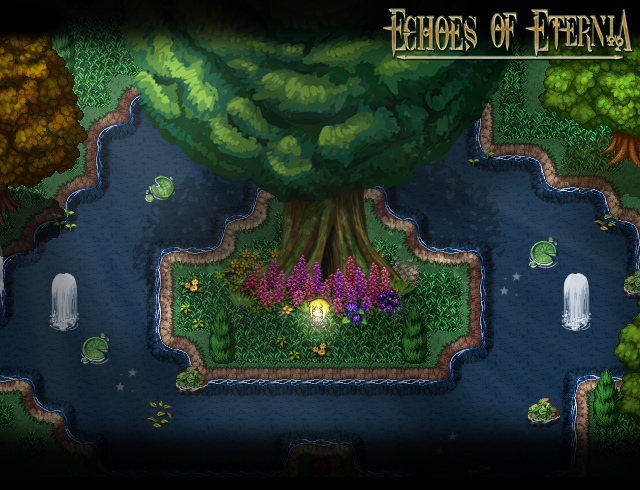 Those two aren’t the only ones who only got partially paid, if at all. Alex HW, a Tile Artist, has much the same things to say. “I basically created all the tilesets for the game- so like maybe 90% of the background art you see in all the screenshots was created by me (not the battle screenshots). So all the buildings, terrain, water, caves, sand, furniture, etc- all that kind of stuff was done by me.” He claims to have put hundreds of hours of work into the game, and not getting paid for only 6 of them. “Maybe the very last task or two I might have not been paid, but for the most part I was,” he recalls.
Those two aren’t the only ones who only got partially paid, if at all. Alex HW, a Tile Artist, has much the same things to say. “I basically created all the tilesets for the game- so like maybe 90% of the background art you see in all the screenshots was created by me (not the battle screenshots). So all the buildings, terrain, water, caves, sand, furniture, etc- all that kind of stuff was done by me.” He claims to have put hundreds of hours of work into the game, and not getting paid for only 6 of them. “Maybe the very last task or two I might have not been paid, but for the most part I was,” he recalls.
HW did discover news about a third party investor, the same that Melissa Hui Wang mentioned in her email to the inquisitive backer. “In January 2014, I was told that he [Ryan Harmon] was working with an investor now since all the Kickstarter funds were used up, that he had to wait for his next batch of funding so that he could pay me.” Unfortunately, nobody we spoke to knows anything about this investor beyond that; their identity, how much money they invested, or for how long. There is no record on where Harmon spent the Kickstarter money, but video games are extremely expensive. The $43,000 or so raised by the Kickstarter could be drained in an instant once you take away taxes, Kickstarter fees, the new hires, people allegedly taking money without doing any work, and the cost of creating a custom game engine.
That could be why Harmon got a new job before ultimately leaving the project. According to his Linkedin profile, he got a job as a host and cashier at a restaurant in April 2014. This would be four months after telling Alex HW about the investor, and a few months before abandoning the project and going silent. As Chancler Harrison speculates, it could be entirely possible that Harmon ran out of money and was trying to keep things together as best he could. HW said he did eventually get paid after his January 2014 email, including after April of that year.
In June 2014, Harmon contacted the anonymous artist with good news. “Things with the game are going well,” he said over email. “We are working on getting a demo together to show our fans and press. We will have plenty for you to do very soon!” That was the last time they heard from him again. To date, a demo has never been made public. The following month, July 2014, composer Aaron Krogh also spoke to Harmon for the last time. Krogh says he reached out to Harmon for a completed soundtrack of the game, as multiple other composers worked on the music as well. “He gave me the impression that the game would be finished in about six months,” he said. After that, he never heard from Harmon again.
DellaFave
In each of these communications, one name is consistently brought up: Robert DellaFave.
DellaFave is another game designer, even launching his own Kickstarter for Hiro Fodder in May 2012. In an update posted on that campaign in November 2014, he says he and Harmon worked together to create the custom game engine that had caused the project so much trouble, something confirmed by Harrison.

Hiro Fodder.
The update states that DellaFave thought Harmon needed more help than that, as he has more experience in game design than Harmon. He stayed with the team in a larger capacity than he first thought he would, essentially leading the team himself at one point. But Harmon disappeared, and hadn’t communicated with him for 5 weeks up to that Kickstarter post, and DellaFave decided to leave the project to work on Hiro Fodder full time. However, Hiro Fodder has also gone MIA, as DellaFave has temporarily ceased production to create other titles with his studio Divergent Games.
A lot changed once DellaFave began working with the team. However, nobody we spoke to knows much about him, and most hadn’t even worked with him at all. Melissa Hui Wang says she never heard of him prior to our interview. Chancler Harrison says DellaFave forced him to go back and change his work, and even threw some of it out with his knowledge. When he approached Harmon with this, he was equally confused, but did nothing about it.
“Sorry Rob wants these changes,” Harmon said in a Facebook message. “Idk why he wants to make us work on things that are done… I’m bummed too. But I just want to get this done.” He asked Harmon if DellaFave was taking over as director, and was told: “He hasn’t taken over, but I’ve given him more input and responsibilities. It’s for the best. Everything is run by me first.”
Robert DellaFave did not respond to our request for interview.
An Expanding Web
Ryan Harmon wasn’t afraid of cross-promoting other Kickstarter campaigns. He had done two over in as many updates, one for the RPG Soul Saga, and one for a fashion company called Yume Sweet Dreams. In both instances, Harmon claimed to be friends with each, going so far as to say the founders of Yume Sweet Dreams were his BFF’s, and modeling in some of their photos. Both Kickstarter campaigns for Yume Sweet Dreams failed to raise funding, and have since dissolved. They could not be reached for comment.

Ryan Harmon modeling for Yume Sweet Dream’s Kickstarter.
In the update for Soul Saga, Harmon says he was talking to project director Mike Gale “for months after he initially contacted me about helping him set up his Kickstarter page and to give him tips on getting noticed.” He went on to say that “you can expect to see some cool stuff developing between us,” and that they talked about working together in other areas.
As Gale tells us, that isn’t exactly the case. “That post was meant to be a simple cross promotion. Echoes of Eternia [sic] mentioned me to their fans, and I was going to mention them to my fans when they released,” he says. He talks about Kickstarter campaigns frequently doing cross promotions, and that he never spoke to Harmon or anyone on the EoE team until just before that update was posted. “However it seems he made some ambiguous comments that implied we were doing something more than that. I have no idea why he would make them because that certainly wasn’t the case.”
Gale says he has not, and is not working on any project other than his own, and knows nothing about Ryan Harmon or Echoes of Eternea at the moment. Though he did speak to Harmon about the status of the project before this update. He recalls talking to Harmon about the game’s engine, and Harmon telling him about a custom engine they were working on. “I recommended that they just use an engine like Unity instead to reduce the workload, but he didn’t seem interested in that. That was the extent of our conversations regarding project development.”
Resurrection. Or Not
Jeremy Hill’s attempt at resurrecting the Echoes of Eternea has provided little comfort for backers. The sub-Reddit for the project hasn’t seen an update in about five months, with new posts coming infrequently before that. For the most part, the forum has acted more as an advertisement for Hill’s comic strip than a source of information about the game. Even the comic doesn’t receive updates anymore, with the last page coming around September 2016. Two former team members have purported to have shared their work and offer further services to Hill, but he turned them away or ignored them.
Robert DellaFave talks about Echoes of Eternea sporadically in his Hiro Fodder updates. In a recent update, DellaFave promises to give away free copies of his latest game to Echoes backers as a means of making amends. The update says DellaFave can’t contact backers directly because he doesn’t have control over Harmon’s Kickstarter account, so he’s asking his own backers to send them over to him. The last sign in on Harmon’s Kickstarter account came in April 2016, well after Harmon abandoned the project.
The only thing we can say with certainty is that Echoes of Eternea, the Kickstarted version led by Ryan Harmon or possibly Robert DellaFave, is dead. Harmon has scrubbed any mention of the game from his social media accounts, and isn’t in communication with anyone from the project.
It’s my belief that Harmon did not take the money and run off with it. He continued working on the game for two years after the Kickstarter campaign ended, and got that job as a Host before quitting the game for good. You have to remember that a lot of the $43,196 would have gone to Kickstarter fees and taxes before Harmon got any of it. After that, he had to pay for the custom engine, which is itself a massive money sink. Then he had to pay his numerous staff, those we spoke to for this article, as well as Enemy Artist EW Hekaton, Lead Narrative Designer Paul Marzagalli, Artist Rebecca Lemker, and Composers Aaron Krogh and Aakaash Rao.
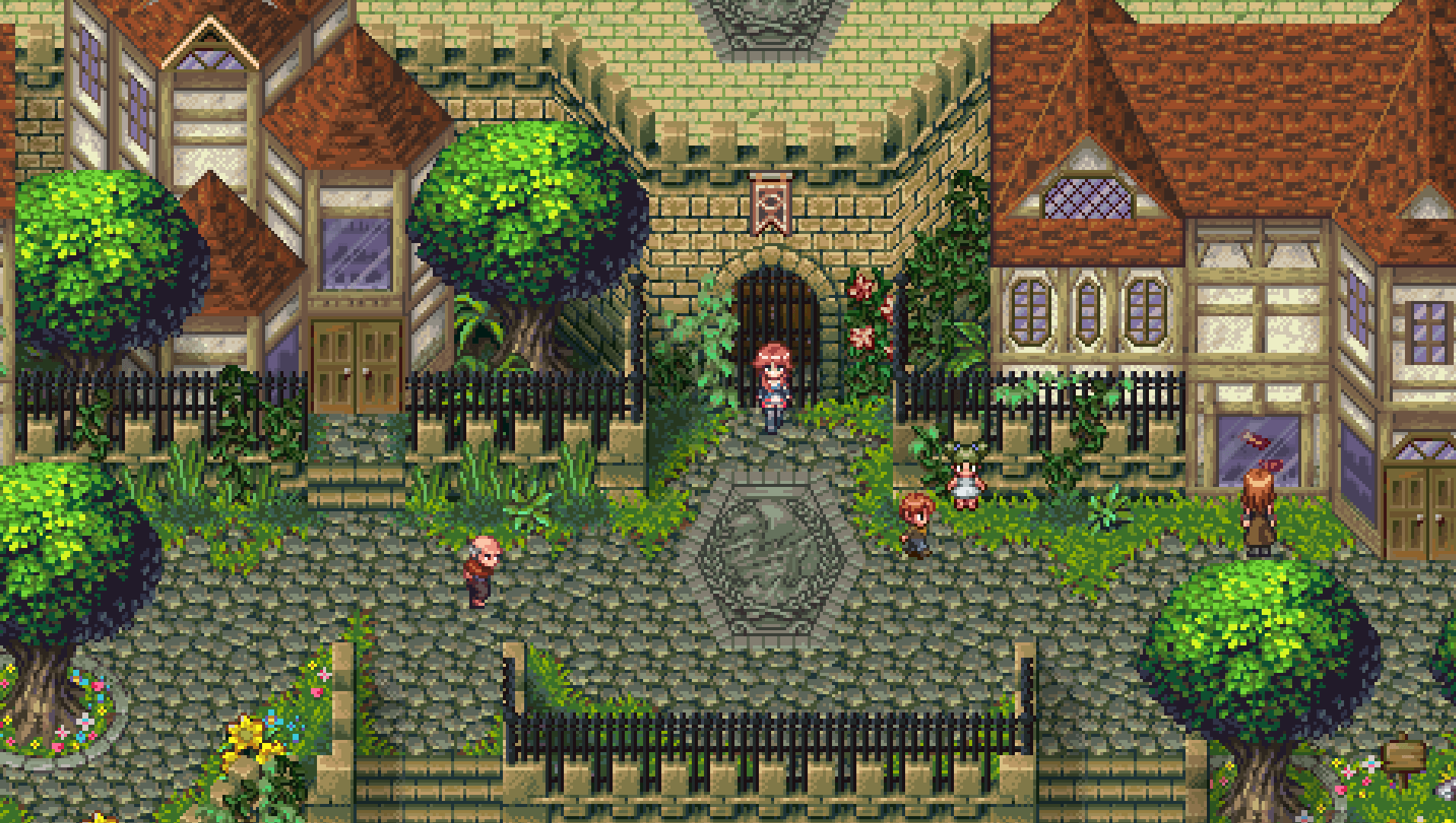
It’s remarkable how many people who worked on this project loved working with Harmon. Almost everyone we spoke to seems to agree that he was nice, caring, and a good director, even in the face of allegations that he didn’t pay some of his employees, and vanishing without a trace.
“He legitimately wanted to create and finish the game,” said Alex HW. “I have absolutely no doubts about that. I got the impression that he tried his best to make things work and he always acted polite and professional.”
“Ryan was a friendly guy and was clearly passionate about EoE, but I did get the sense that he was in over his head,” said composer Aakaash Rao.
“What little interaction I had with Ryan was pleasant; he seemed passionate about his project, like most other creators I’d met from RPGmaker forums. In our last conversation he suggested that he was under a lot of stress but that the game was coming along just fine,” Rao’s composing partner, Aaron Krogh echoed.
“He was very patient with my deliverables!” Mellisa Hui Wang answered. “He exuded a pleasant demeanor and a patient open-mindedness. He sought to deliver critiques and requests gently. I am not certain about why he has “seemingly disappeared,” but I very much hope that he’s alright.”
Moving On
Many on the EoE team want to put this behind them. They each exude a sense of regret over how things turned out, one way or another. Someone didn’t want to speak on record, some gave short replies, others wrote pages of notes with quotes from Harmon and shared never before seen screenshots. They all seem to have enjoyed their time working on the game, and hate that backers will never get to see any of it. Composer Angelo Cicero summed up the team’s feeling best.
“I feel bad for everybody who worked on it, but most of all for the backers who pledged their hard earned money to “promising” project. […] Until you contacted me, I had just made peace with the fact that nothing will come of the game. Hopefully [this] story can act as a cautionary tale for other developers looking to crowd-fund.” Of Harmon, he too had positive things to say. “I wouldn’t crucify Ryan, I think he had the best intentions. He seemed passionate and excited for the minimal amount of interaction I had with him.”
That was one final theme amongst all of these emails – the hope that this can act as a warning. Maybe even a step-by-step guide for how not to conduct a Kickstarter campaign, and lead a video game development team. Even Chancler Harrison, claiming to have never been paid a single cent, chooses to look on the bright side.
“People can learn from this,” he said. “If I were to ever see Ryan walking down the street… I would give him a big hug.”


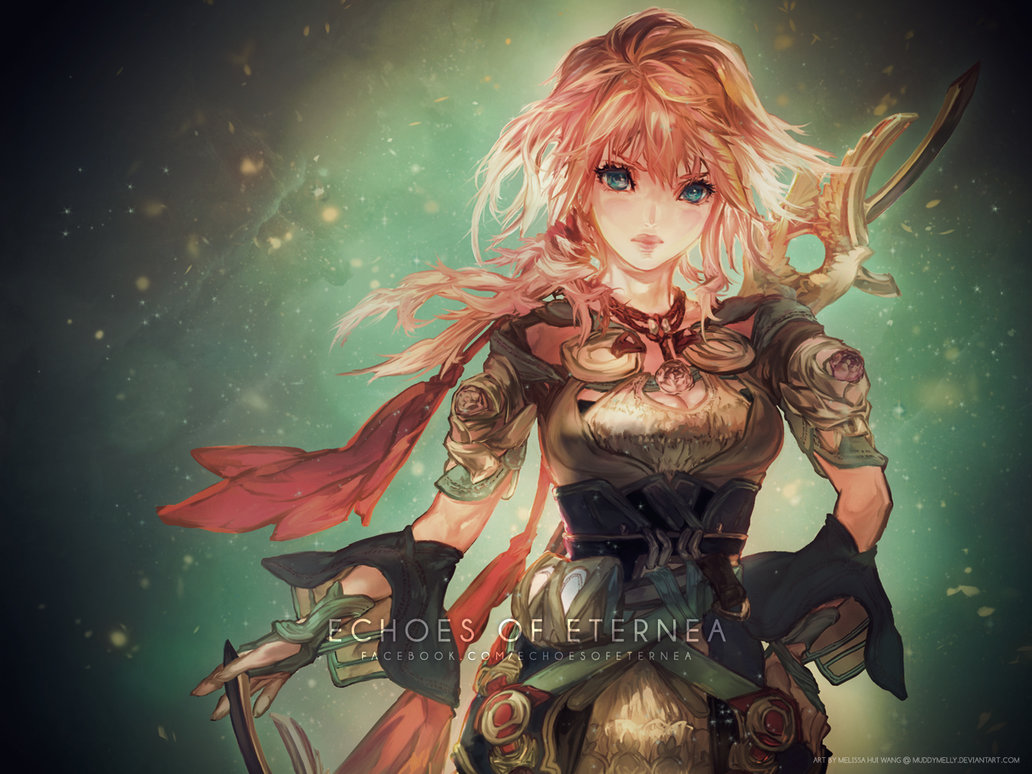
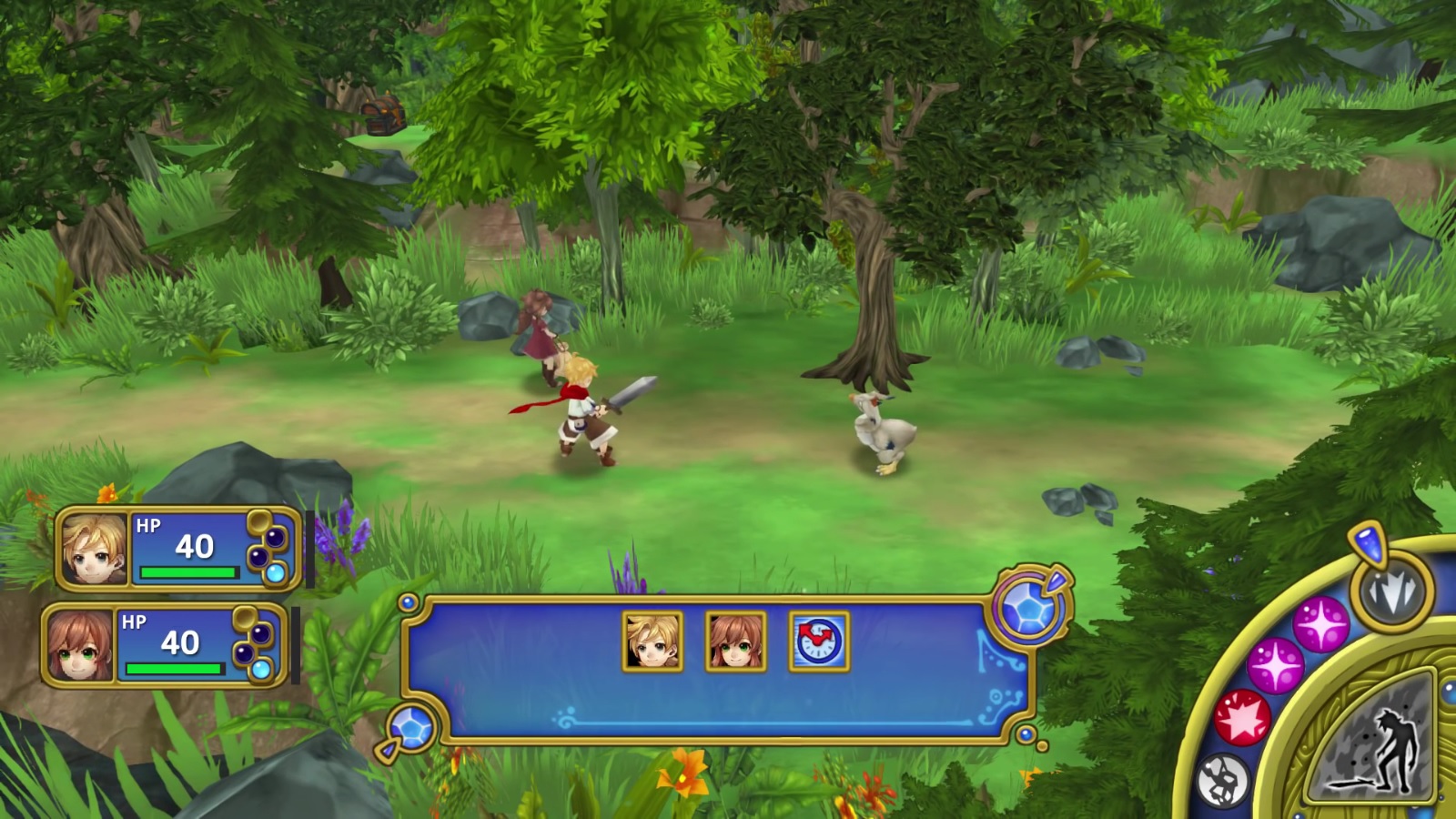
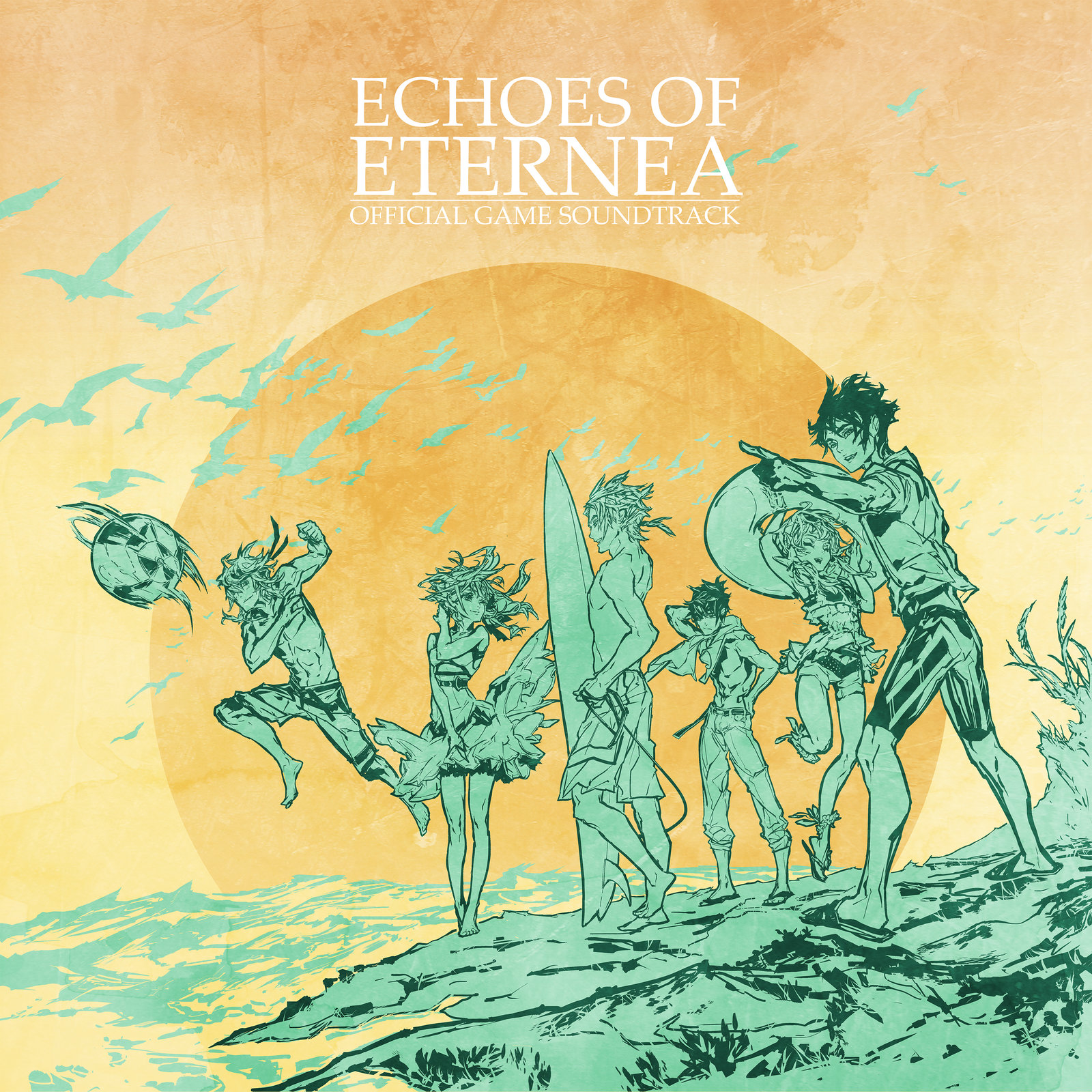



Hi Josh, that’s a very interesting story. It looks like you did a lot of research and I’m glad you went into detail. Cliqist is becoming one of my favorites.
Thank you very much, Val! About two months of research went into this piece, and while I wish I could have got into contact with Harmon or DellaFave, I’m still glad that people, especially EoE backers, are taking solace in it.
Great and well-researched article. Really enjoyed reading this one.
Thanks, I’m glad you enjoyed it.